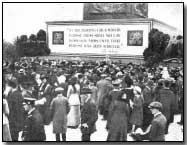Encyclopedia - White Feathers
 Chiefly a phenomenon of
Britain, white feathers were typically handed over by young women to men out
of uniform during wartime, the implication being that the man concerned was
a 'shirker' or a coward. The co-called 'Organisation of the White
Feather' was initiated by Admiral Charles Fitzgerald in the opening month of
the war and was encouraged by a number of writers, including Mary Ward.
The organisation was founded as a means of applying pressure to able bodied
men to enlist with the British Army.
Chiefly a phenomenon of
Britain, white feathers were typically handed over by young women to men out
of uniform during wartime, the implication being that the man concerned was
a 'shirker' or a coward. The co-called 'Organisation of the White
Feather' was initiated by Admiral Charles Fitzgerald in the opening month of
the war and was encouraged by a number of writers, including Mary Ward.
The organisation was founded as a means of applying pressure to able bodied
men to enlist with the British Army.
The practice of handing out white feathers gathered pace in 1915 as the result of a growing perception of manpower shortages, and continued sporadically for the remainder of the war. Even soldiers home on leave - and out of uniform - found themselves the (inevitably disgusted) target of bearers of white feathers.
For those men who necessarily remained at home in key state industries the effect of being presented with white feathers was often one of shame (although the pacifist Fenner Brockway proudly noted that he had enough feathers with which to make a fan).
The government's response - in the shape of Home Secretary Reginald McKenna - was to authorise production of a badge bearing the legend "King and Country", thus marking out its wearer as someone effectively excluded from overt moral pressure to enlist.
Photograph courtesy of Photos of the Great War website
Around one million Indian troops served in WW1, of which some 100,000 were either killed or wounded.
- Did you know?
